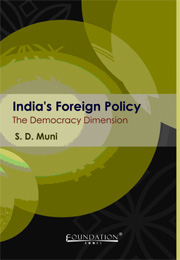Book contents
- Frontmatter
- Contents
- Preface
- 1 Introduction
- 2 The Nehruvian Phase: Ideology Adjusts with Realpolitik
- 3 Nehru's Successors: Realism Takes Command
- 4 Imperatives of the New Millennium
- 5 An Overview
- Appendix I Warsaw Declaration on Community of Democracies, June 2000
- Appendix II Santiago Commitment; Community of Democracies, April 2005
- Appendix III PM's Address to Joint Session of the US Congress, July 2005
- Appendix IV PM's Speech at the Foundation Stone Laying Ceremony of Afghan Parliament, August 2005
- Appendix V PM's Speech at the UN Democracy Fund, September 2005
- Appendix VI PM's Speech at the Conference on Democracy, Development and Social Inclusion, December 2005
- Index
3 - Nehru's Successors: Realism Takes Command
Published online by Cambridge University Press: 26 October 2011
- Frontmatter
- Contents
- Preface
- 1 Introduction
- 2 The Nehruvian Phase: Ideology Adjusts with Realpolitik
- 3 Nehru's Successors: Realism Takes Command
- 4 Imperatives of the New Millennium
- 5 An Overview
- Appendix I Warsaw Declaration on Community of Democracies, June 2000
- Appendix II Santiago Commitment; Community of Democracies, April 2005
- Appendix III PM's Address to Joint Session of the US Congress, July 2005
- Appendix IV PM's Speech at the Foundation Stone Laying Ceremony of Afghan Parliament, August 2005
- Appendix V PM's Speech at the UN Democracy Fund, September 2005
- Appendix VI PM's Speech at the Conference on Democracy, Development and Social Inclusion, December 2005
- Index
Summary
Security considerations for India were heightened in the neighbourhood with two major conflicts precipitated with China in 1962 and Pakistan in 1965. There are analysts who attribute the end of Nehru's era in India's foreign policy to the war with China. He barely survived eighteen months after being shocked by the Chinese attack. We have already noted Nehru's acceptance of failure of his China policy when he said; “we were living in a world of our own creation”. It was within his lifetime that he had to moderate his stance on democracy in relation to Nepal and Myanmar as a consequence of the Chinese aggression. He also had to seek military support from the West to face the Chinese challenge and nearly accept the Western conditions of seeking a solution of the Kashmir problem with Pakistan to the latter's satisfaction. It was the Pakistani obstinacy and its strategy to forge a strategic equation with China in 1963, even by conceding a part of Kashmir territory to settle Sino-Pak border issue, which helped Nehru wriggle out of the possibility of an uncomfortable compromise. The war imposed on India by Pakistan in 1965, it is said, cost the life of Nehru's successor. Prime Minister Lai Bahadur Shastri died of heart attack in Tashkent hours after signing a peace agreement with Pakistan under the Soviet mediation.
- Type
- Chapter
- Information
- India's Foreign PolicyThe Democracy Dimension, pp. 55 - 85Publisher: Foundation BooksPrint publication year: 2009



